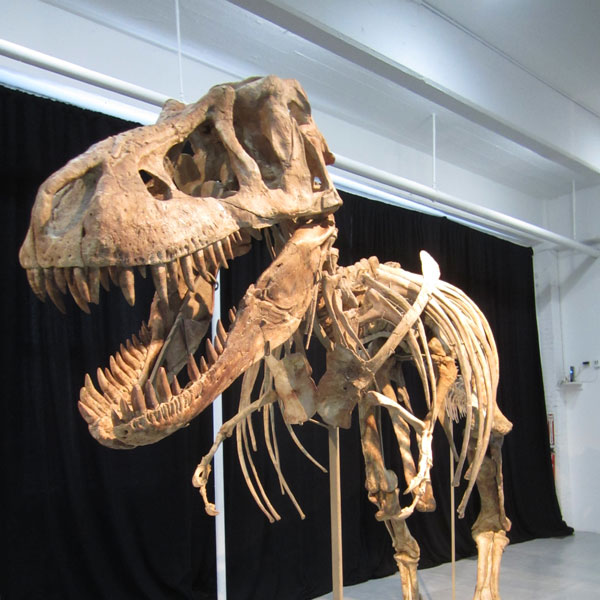Tyrannosaur Is Truly Mongolian, Experts Declare, Challenging Sale

NEW YORK — A dinosaur skeleton auctioned in May had been taken out of Mongolia, most likely within the past 10 years, American and Mongolian paleontologists have concluded, which would mean the specimen was removed illegally.
"We have pulled a lot of them out of the ground and seen a lot of others come out of the ground, and in our professional opinion it is from Mongolia," said Mark Norell, a paleontologist at the American Museum of Natural History who began working in the Central Asian country in 1990.
Norell and fellow investigator Philip Currie, a paleontologist at the University of Alberta, first announced their findings to reporters on Wednesday (June 6). Two Mongolian paleontologists also assessed the fossils and came to the same conclusion.
It is not yet clear how this conclusion will affect the sale of the specimen, the 75 percent complete skeleton of a type of tyrannosaur called Tarbosaurus that was sold May 20 to an anonymous bidder for $1.1 million on condition that the sale receive court approval.
"I have no doubt that the Tarbasaurus bataar will be returned to Mongolia," said Puntsag Tsagaan, senior adviser to Mongolian President Elbegdorj Tsakhia, following the investigators' conclusions.
The return of the specimen, which is an Asian relative of the North American Tyrannosaurus rex, not only would be a sign of good relations between the United States and Mongolia, but would send a strong message to the "bad guys, those who illegally excavate fossils and sell them on the black market," Tsagaan said. Under Mongolian law, dinosaur fossils excavated within the country's borders are state property.
Heritage Auctions, which handled the sale, has cooperated with the Mongolian investigation into its origins. On Wednesday the auction house gave paleontologists and representatives of the Mongolian government access to the facility in the borough of Queens where the Tarbosaurus was being stored. [Up For Auction: A Natural History Gallery]
Get the world’s most fascinating discoveries delivered straight to your inbox.
Jim Halperin, co-chairman and co-founder of Heritage Auctions, said in a statement, "It would be premature for us to comment on a paleontological opinion we have neither seen nor had time to study.
"Heritage will continue to assist the ongoing efforts to achieve a fair and amicable resolution," he added.
The whitish to beige color of the fossils and 12 specific characteristics of the bones made it clear they belonged to a Mongolian Tarbosaurus, said Tsogbaatar Khishigijav, head of the Paleontological Laboratory and Museum at the Mongolian Academy of Sciences.
The skeleton's identity seemed to ascertain its origin; Tarbosaurus bataar remains have been found only in the Nemegt Formation in Mongolia's portion of the Gobi Desert.
Not only did the characteristic light color of the bones point to a Mongolian origin, so did the reddish material in their cracks and fissures, material from their excavation site, said Currie, a paleontologist who studies Tarbosaurus and other tyrannosaurs.
The Tarbosaurus' stubby arm length was among the characteristics that made its identify clear, Currie said.
"The arms of Tyrannosaurus rex are famous because they are short," he said. "In Tarbosaurus they are much shorter."[Tyrannosaur vs. Tarbosaur: What's the Difference?]
The conclusion did not come as a surprise; Currie and Norell were among the paleontologists who previously voiced support for the Mongolian claim that the bones had been smuggled out of the country.
The poaching of fossils in Mongolia has intensified over the years, paleontologists say.
Based on his examination of the bones and his own experience in Mongolia, Currie said he believes the specimen was the subject of two rounds of poaching.
Unskilled poachers often will take the teeth and the claws off a specimen, leaving or destroying the rest, he said. This Tarbosaurus is missing most of its claws and teeth.
The rest of the specimen was removed by excavators with more skill, but even so, the job was not well done, Currie said.
"There is a lot of restoration done on the bones to make them look good, but when you look closely at it you can see there is a lot of plaster restoration towards the ends of the bone, a lot of the processes [protrusions] are broken or chipped off and gone," Currie said.
Mongolia's first priority is to get the Tarbosaurus fossils returned; then it will address the problem in general, said Tsagaan said – possibly through domestic legislation or use of its own agencies and cooperation with other nations.
Other paleontologists have been following this dinosaur's American adventure.
"I think it's good for this case to come up because one of the things that happens, a lot of fossils are being brought into this country and sold in this country and there is not too much awareness of fossil collecting laws in other countries," said Kirk Johnson, chief curator and vice president for research and collections at the Denver Museum of Nature & Science. "Mongolia owns all its fossils, not like the U.S.," where people can dig up fossils on their private land and own them.
"The fact it is here means a law was broken," Johnson told LiveScience.
Follow Wynne Parry on Twitter @Wynne_Parry orLiveScience @livescience . We're also on Facebook & Google+.



